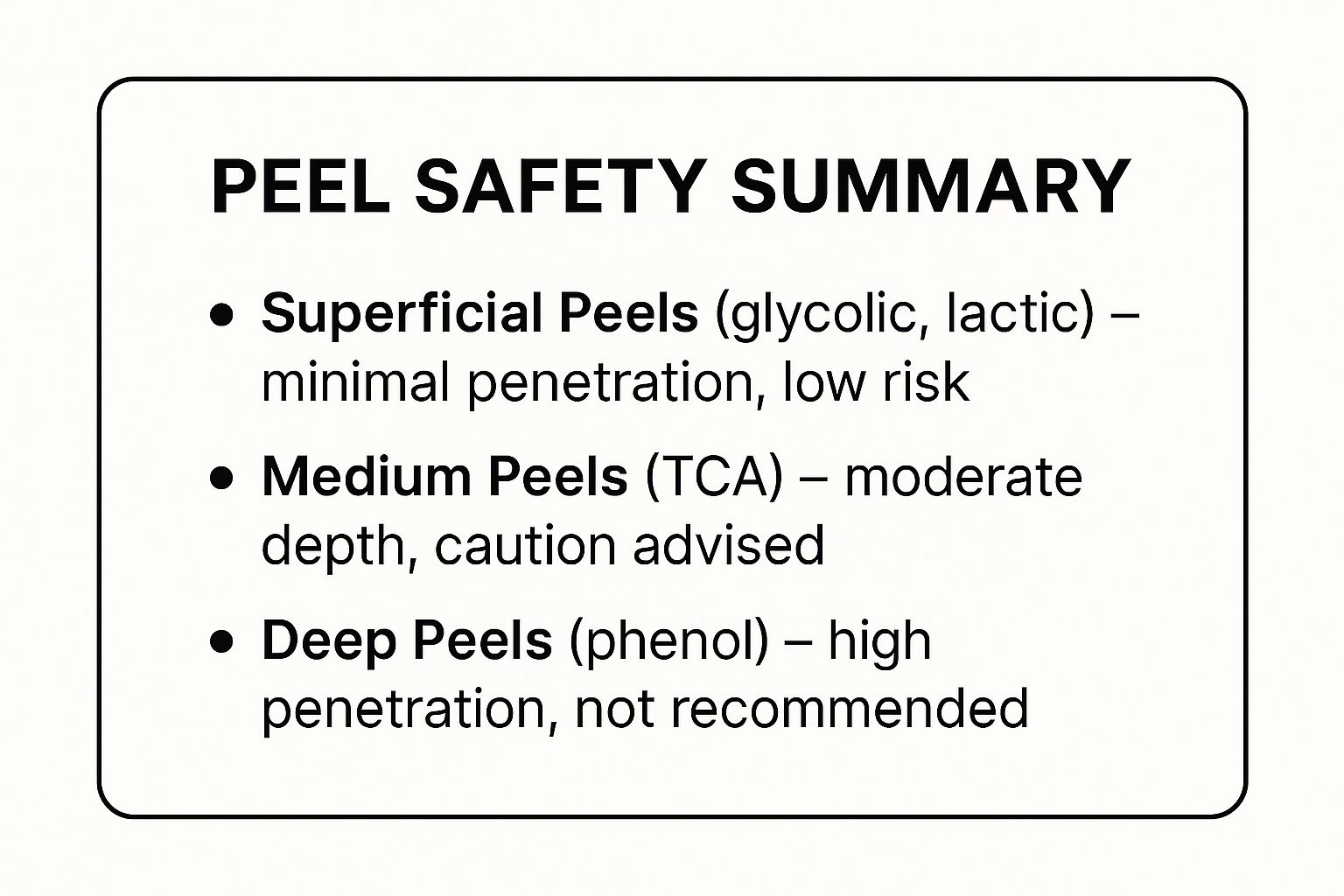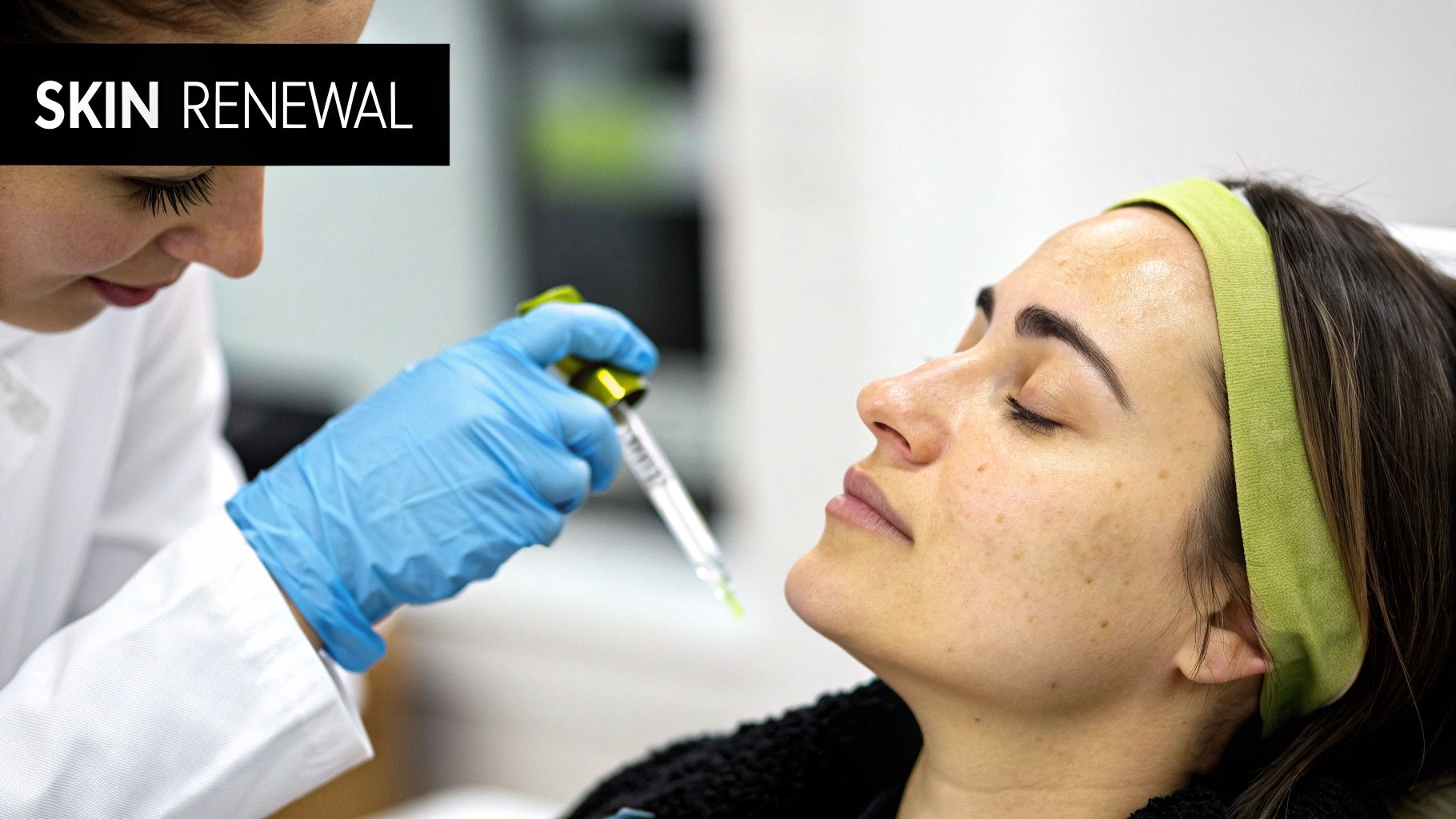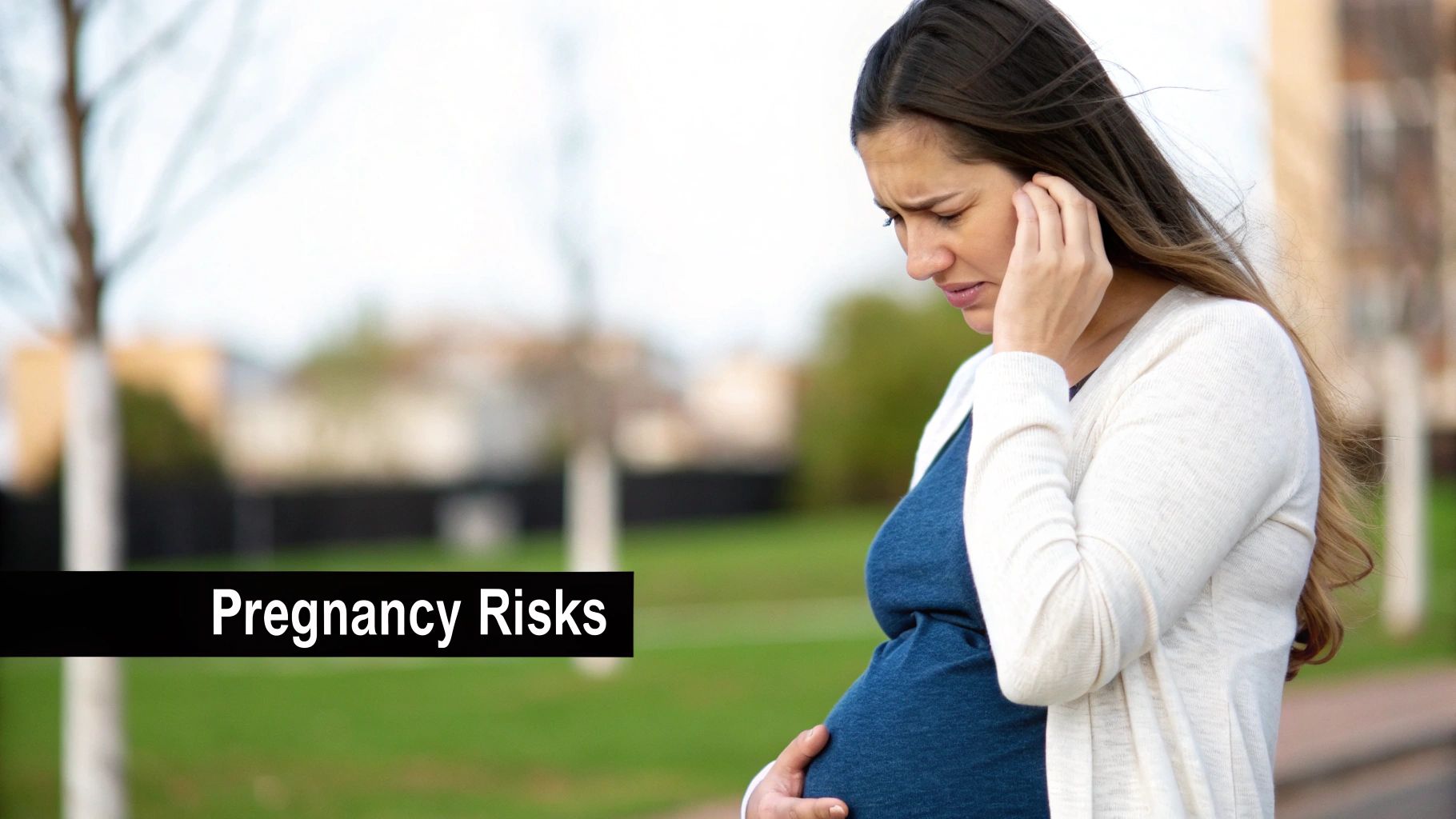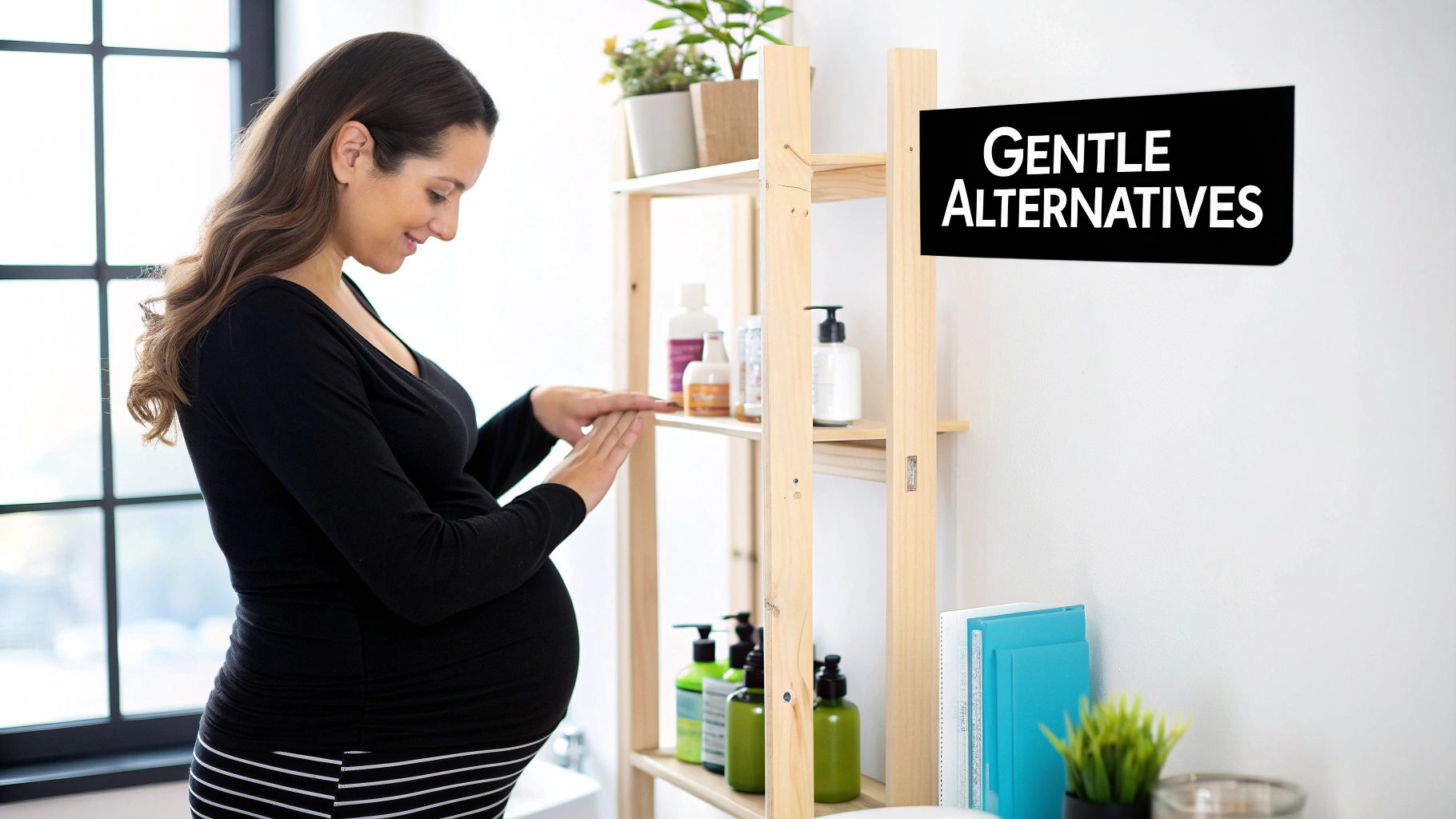
Chemical Peels While Pregnant A Complete Safety Guide
The short answer? Most experts agree: when it comes to chemical peels during pregnancy, the best approach is extreme caution. While some of the very mildest, most superficial peels might get a green light from your doctor, anything stronger is almost universally considered off-limits until after you’ve had the baby.
The Honest Truth About Chemical Peels During Pregnancy
Pregnancy brings a wave of incredible changes, and your skin is right there along for the ride. Think of your body as a high-security fortress, working around the clock to protect your growing baby. This heightened state of alert makes your skin more sensitive, more reactive, and honestly, a lot more unpredictable thanks to all those hormonal shifts. A treatment that your skin loved before could suddenly cause a major issue.
The biggest worry with getting a chemical peel while you're pregnant is something called systemic absorption. This is the risk that the active chemicals in the peel could seep through your skin, get into your bloodstream, and potentially affect your baby. It’s exactly why the professional consensus is to steer clear of most peels, especially any that work deeper than the very top layer of skin.
Understanding the Risks
During pregnancy, those hormonal surges put your melanin-producing cells on overdrive. This makes your skin way more prone to post-inflammatory hyperpigmentation (PIH), which is just a technical term for the dark spots that can pop up after any kind of skin irritation or "trauma." A chemical peel, even a gentle one, is essentially a controlled injury designed to trigger renewal. On hormonally sensitive skin, this process could backfire and leave you with new dark patches—the very problem many people use peels to fix!
The guiding principle for skincare during pregnancy is simple: minimize any and all unnecessary chemical exposure. No cosmetic result is worth even the smallest potential risk to your baby's health.
For a quick overview, this table breaks down the general recommendations for different types of peels.
Chemical Peel Safety During Pregnancy At A Glance
Peel Type General Recommendation During Pregnancy Primary Concern Superficial/Light Peels Use with extreme caution and only with doctor/dermatologist approval. Skin hypersensitivity; potential for unpredictable reactions like hyperpigmentation. Medium Peels (e.g., TCA) Not recommended. Higher risk of systemic absorption of chemicals; increased risk of scarring and pigmentation issues. Deep Peels (e.g., Phenol) Strictly avoid. Significant risk of chemical toxicity and absorption, which could pose a danger to fetal development.
As you can see, the deeper the peel, the more serious the concerns become.

This visual guide really drives the point home. The further a peel penetrates, the greater the potential risk during pregnancy, which is why superficial options are the only ones even worth discussing with a professional.
Why Medium and Deep Peels Are Not Recommended
The real safety issues stem from the specific chemicals used in those more powerful peels. Medium and deep peels, especially those using trichloroacetic acid (TCA) or phenol, are a definite no-go for pregnant women because of the high risk of toxicity. Your skin's increased sensitivity also means the chances of a bad reaction—like burns, scarring, or severe pigmentation changes—are much, much higher.
Ultimately, this special time calls for a different skincare philosophy. It’s less about aggressive treatments and more about gentle, supportive maintenance. While you'll have to press pause on certain procedures, a professional can help you find wonderfully effective and safe ways to keep your skin healthy and happy. If you're planning ahead, you can always schedule a personalized chemical peel consultation to create the perfect post-pregnancy skincare strategy.
Why Pregnancy Transforms Your Skin

Pregnancy is a time of incredible change, and your skin is often front and center for the transformation. One minute you might have that legendary "pregnancy glow," and the next you're dealing with breakouts or dark spots you've never seen before. If this sounds familiar, you can thank your hormones. Understanding this profound biological shift is the key to figuring out why skincare treatments that used to be your go-to, like chemical peels while pregnant, suddenly need a much more careful approach.
Think of your body’s hormonal balance like a symphony orchestra that has played the same beautiful music for years. Suddenly, pregnancy comes along and cranks the volume on two key instruments: estrogen and progesterone. This surge is absolutely vital for supporting a healthy baby, but it also throws your skin’s normal rhythm completely off-kilter.
The Hormone and Melanin Connection
One of the biggest ways these hormones impact your skin is by talking directly to your melanocytes—the tiny cells that produce melanin, the pigment that gives your skin its color. During pregnancy, estrogen and progesterone basically put these cells on high alert, making them overachievers.
This hyperactivity makes your skin incredibly prone to hyperpigmentation, where patches of skin become darker than the surrounding areas. The classic example of this is melasma.
Melasma, often nicknamed the "mask of pregnancy," shows up as blotchy, brownish patches on the face—usually the forehead, cheeks, upper lip, and nose. It’s incredibly common, with up to 70% of pregnant women noticing some degree of it.
This is exactly why we have to be so cautious with certain treatments. A chemical peel, by design, creates a controlled injury to the skin to kickstart cell renewal. But when you apply that process to hormonally-charged skin, you risk sending those overactive melanocytes into overdrive. The result? You could accidentally make existing dark spots worse or even create new ones.
Increased Sensitivity and Reactivity
It’s not just about pigmentation. That hormonal flood can make your skin feel like a stranger—more sensitive, easily irritated, and generally more reactive than ever before. Your favorite moisturizer might suddenly cause redness, or your trusted cleanser could lead to a breakout.
This heightened sensitivity means your skin’s protective barrier is much more fragile. Using a strong chemical exfoliant under these conditions can be a recipe for trouble, leading to:
More irritation and redness that sticks around for far too long.
A higher risk of post-inflammatory hyperpigmentation (PIH), which are dark spots left behind after inflammation.
Completely unpredictable results that look nothing like what you experienced before pregnancy.
Your skin is essentially playing by a whole new set of rules for nine months. Recognizing this hormonal reality is the first and most important step. It’s why hitting pause on more aggressive procedures isn’t just a recommendation—it's a critical part of ensuring your skincare routine is safe and supportive for both you and your baby.
Exploring Safer Peel Options With Your Doctor

While the more intense chemical peels are definitely off the table during pregnancy, there are a few very gentle, superficial options that might be okay under strict medical guidance. This isn’t a green light to book an appointment, but rather a starting point for a serious conversation. Your first move should always be a detailed chat with both your dermatologist and your OB-GYN to see if any kind of peel is truly a safe choice for you.
Think of it this way: if you were cooking for someone with a sensitive stomach, you'd skip the habaneros and reach for mild herbs instead. It’s the same logic here. When we talk about chemical peels while pregnant, the goal isn't dramatic resurfacing. It's about gentle, surface-level exfoliation.
The only peels even worth discussing are superficial ones using low concentrations of alpha-hydroxy acids (AHAs), like Lactic Acid or Glycolic Acid.
Why Some AHAs Are Considered Lower Risk
The main reason these specific acids are even considered is because they don't sink very deep into the skin. Unlike aggressive peels that penetrate down to the living layers of your dermis, these gentle AHAs work almost entirely on the stratum corneum—the very top layer of dead skin cells.
This is a critical point. Because they stay on the surface, the risk of the acid getting absorbed into your bloodstream (what we call systemic absorption) is dramatically lower. This makes them fundamentally different from the high-risk medium or deep peels.
Of these, some evidence points to lactic acid as a potentially suitable option. Generally, AHA peels are the most common and are thought to be safer during pregnancy. Because they only slough off the outermost layer of skin, they don't penetrate deep enough to reach blood vessels, which limits your body's overall exposure. In fact, lactic acid peels have been used to safely treat gestational acne with no reported negative impacts on pregnancy outcomes. You can read more about the safety profiles of different peels for a deeper dive.
Key Questions for Your Doctor
If you and your doctors agree to explore this route, you need to go into your appointment prepared. An informed conversation is the only way to ensure everyone is on the same page.
Crucial Takeaway: A doctor's approval is non-negotiable. Trying at-home peels or visiting a spa without direct medical clearance is a risk you shouldn't take during pregnancy, no matter how "gentle" a product claims to be.
Here are the exact questions you should ask to make a safe and fully informed decision:
What is the exact concentration of the acid? When you're pregnant, lower is always better. You need to confirm the percentage is well within the range your doctor considers safe.
What is the pH of the peel solution? The pH level is just as important as the concentration; it dictates the peel's strength and how irritating it might be.
Are there any pre-peel or post-peel products I have to avoid? Your entire skincare routine will need a once-over to make sure nothing will interact poorly with the treatment.
For my specific skin issues (like melasma or acne), what are the realistic results and risks? You need a frank assessment of whether the potential reward is worth the heightened risk of post-inflammatory hyperpigmentation your skin already has.
Peels and Ingredients You Must Avoid
While we can talk about some very gentle options with your doctor, certain treatments and ingredients are on the non-negotiable list. Navigating the world of chemical peels while pregnant means putting safety first, always. It’s about confidently saying "no" to peels that pose even a small risk, no matter how good the promised results sound.
Think of it this way: a strong peel works by intentionally creating a controlled wound to the skin. The problem is that its active ingredients can travel beyond the skin's surface. The big worry here is systemic absorption—where those chemicals get into your bloodstream and could potentially reach your baby. That risk, paired with how sensitive your skin already is due to hormones, makes avoiding certain peels a medical necessity.
High-Risk Peels and Ingredients
The peels on this list are considered unsafe during pregnancy. This is due to how deep they penetrate, the chemicals they contain, and their potential for toxicity. It's really important to know these names and understand exactly why they're off-limits.
Trichloroacetic Acid (TCA) Peels: You might see a dermatologist use a tiny, low-dose amount for a very specific spot treatment, but medium-to-high concentration TCA peels are a definite no. These peels sink deep into the skin, and the risk of the acid being absorbed into your system is just too high. Plus, pregnancy hormones can make your skin react in unpredictable ways, leading to scarring or severe hyperpigmentation.
Phenol Peels: This one is the deepest and most aggressive peel available, and it must be strictly avoided during pregnancy, with no exceptions. Phenol is known to be cardiotoxic (toxic to the heart) and can be absorbed systemically, creating a serious danger to your developing baby.
Salicylic Acid (BHA) Peels: Salicylic acid belongs to the salicylate family, which is chemically related to aspirin. We avoid high doses of oral aspirin during pregnancy, and the same logic applies here. Significant amounts of salicylic acid absorbed from a professional peel could pose a similar risk. A tiny bit in a daily face wash is generally fine, but a full-face peel is off the table.
Your aesthetician or dermatologist should be your partner in safety. If you are ever offered one of these treatments during pregnancy, it’s a major red flag. A knowledgeable professional will always prioritize your and your baby's health over a cosmetic outcome.
There's no denying the incredible results a well-chosen peel can deliver, but timing is truly everything. You can get excited about your post-pregnancy skincare goals by looking at these chemical peel before and after results to see what's possible when the time is right.
For now, your focus should be on gentle, nurturing care. Protecting your health during this special time is the most beautiful glow-up of all.
Safe and Effective Alternatives for Glowing Skin

Just because you're putting chemical peels on hold while pregnant doesn't mean you have to give up on having that healthy, radiant skin. It’s actually a wonderful opportunity to shift your focus from intense resurfacing treatments to more gentle, nurturing care.
Think of it like tending a garden. Instead of using powerful, aggressive chemicals, you're now focused on enriching the soil and providing the best nutrients to help everything flourish naturally. The fantastic news is that plenty of effective and pregnancy-safe alternatives can tackle concerns like dullness, breakouts, and uneven skin tone.
Professional Treatments That Nurture Your Skin
Even without peels, your esthetician is still your best friend for skincare. Several professional treatments are widely considered safe during pregnancy and deliver beautiful results. These services work by nourishing your skin and refining it mechanically, sidestepping any potentially risky chemicals.
Here are a few great options to discuss with your skincare pro:
Hydrating Facials: A deep, professional hydrating facial is pure bliss for thirsty pregnancy skin. Using carefully selected, pregnancy-safe ingredients, these treatments calm sensitivity and bring back that supple, dewy look we all crave.
Light Microdermabrasion: This isn't as scary as it sounds! It's a non-chemical procedure where an esthetician uses a minimally abrasive tool to gently buff away the outermost layer of dead, dull skin. Done correctly, it’s a fantastic way to improve texture without any chemical absorption.
Certain LED Light Therapies: Some wavelengths of LED light are generally considered safe during pregnancy. Red light, for example, is great for calming inflammation and encouraging collagen, while blue light can help manage acne-causing bacteria on the skin's surface.
A quick but important note: Always, always get the green light from your OB-GYN before booking any new professional treatment, no matter how low-risk it seems. Keeping your doctor and esthetician in the loop ensures everyone is on the same page about your and your baby's safety.
Powerhouse At-Home Ingredients
Your secret weapon for maintaining radiant skin throughout your pregnancy is a solid at-home routine packed with safe, effective ingredients. These are the workhorses of pregnancy skincare, known for delivering results without the risks.
Top Pregnancy-Safe Skincare Ingredients
Ingredient Primary Benefit Why It's a Great Alternative Azelaic Acid Fights acne & pigmentation A true star for expecting moms. It's a fantastic stand-in for retinoids and stronger BHA peels, helping to unclog pores and visibly fade dark spots, including melasma. Vitamin C Brightens & protects This powerful antioxidant is your daily defense against environmental stressors. It works wonders for brightening your overall skin tone and giving you that coveted glow. Hyaluronic Acid Deeply hydrates Think of this as a super-sponge for your skin. It can hold up to 1,000 times its weight in water, which means it instantly plumps up your skin, softening fine lines and soothing sensitivity.
Weaving these ingredients into your daily routine offers consistent, gentle support for your skin. If you're looking for more ideas, you can explore a handpicked selection of other pregnancy-friendly products in our complete list of non-toxic skincare products.
By embracing these nurturing alternatives, you can feel confident and beautiful, knowing you're keeping your skin healthy without a single compromise on safety.
Figuring out which skincare is safe while you're expecting can be confusing, and that goes double for treatments like chemical peels. You’ve got questions, and you deserve clear, honest answers to feel good about your choices. This is where we'll tackle the most common concerns about chemical peels while pregnant, helping you navigate this time with confidence.
Let's cut through the noise and address those nagging "what ifs," so you can feel secure in your skincare decisions from one trimester to the next.
Can I Get A Mild Glycolic Peel In My First Trimester?
When it comes to the first trimester, the professional consensus is a firm but gentle "no." Your doctor, dermatologist, and esthetician will almost universally advise against any elective cosmetic treatments during this crucial time, and that includes all chemical peels. This period is a critical window for your baby’s organ development, so the name of the game is minimizing any and all potential chemical exposure.
Even though a light glycolic peel has very little chance of systemic absorption, the risk isn't zero. It's always, always better to play it safe. The best course of action is to hold off until at least your second trimester and only move forward after getting the green light from both your OB-GYN and your skincare professional.
What If I Got A Chemical Peel Before I Knew I Was Pregnant?
First things first: take a deep breath. This happens more often than you'd think, and it's not a cause for panic. The actual risk from a single, superficial peel done before you even knew you were pregnant is considered incredibly low.
The most important thing to do is simply mention it to your OB-GYN at your next visit. They can offer personalized reassurance based on your specific situation. Moving forward, you'll just steer clear of any more peels and switch over to a completely pregnancy-safe routine. A one-off event like this is highly unlikely to pose a problem; the key is being cautious for the remainder of your pregnancy.
The big takeaway here is that a single, accidental exposure is worlds apart from ongoing, intentional treatments. Just let your doctor know for peace of mind and stick to the safe path from here on out.
Are Natural Or Organic Peels Safe During Pregnancy?
This is a marketing trap you don't want to fall into. Words like "natural" and "organic" sound reassuring, but they tell you absolutely nothing about a product's safety during pregnancy. What truly matters are the specific active ingredients, how strong they are, and how they interact with your skin—not feel-good marketing buzzwords.
Plenty of powerful botanical extracts have zero research on their effects during pregnancy. Worse, these so-called "natural" ingredients can still trigger major skin irritation or allergic reactions, especially when your skin is already sensitized by pregnancy hormones. Always judge a product by its full ingredient list and run any type of peel by your doctor first.
How Soon After Giving Birth Can I Get A Chemical Peel?
This is one of those times when patience truly is a virtue. Most experts recommend waiting at least three to six months after you've given birth. And if you're breastfeeding, you'll likely need to wait even longer. Your hormones need time to return to their baseline, and this process has a huge impact on your skin's sensitivity and how well it will heal after a procedure.
If you are nursing, talking to your doctor before a peel is non-negotiable, since some chemicals could potentially find their way into breast milk. The absolute safest bet is to wait until you’ve finished breastfeeding and your regular menstrual cycle has returned before looking into any peels, especially medium or deep ones.
At Olive Skin Therapy, your safety and long-term skin health are our top priorities. When you're ready to bring advanced treatments back into your routine after pregnancy, we'll be right here to build a personalized plan that helps you reach your goals safely and effectively. You can learn more about our approach at https://oliveskintherapy.com.
